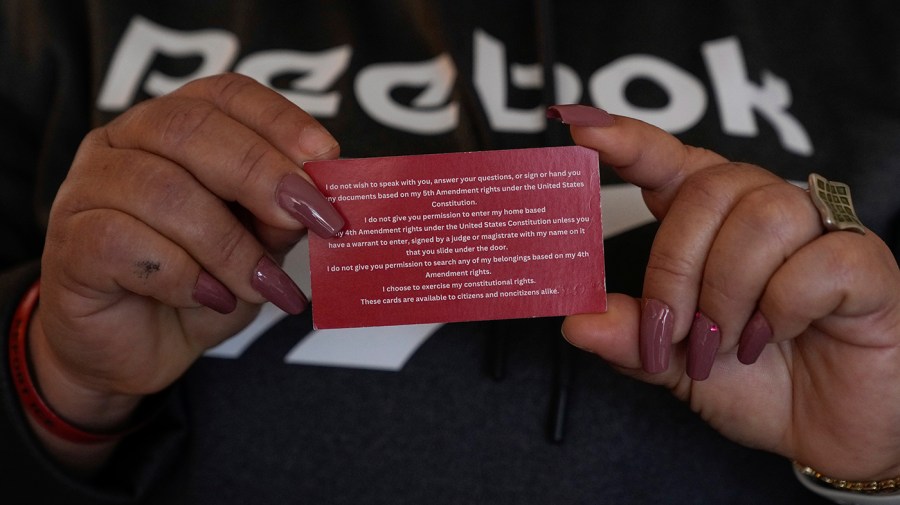Oklahoma is moving to require proof of citizenship for the guardians of public school students, while California schools are distributing “know your rights” cards to immigrant families as K-12 campuses become a crucial front line in President Trump’s immigration crackdown.
Since the Department of Homeland Security rescinded an order that Immigrations and Customs Enforcement (ICE) cannot go into schools, families have been pulling their students out of class and administrators have created action plans on how to handle ICE agents.
But while blue states are moving to shield their students, some red ones are embracing Trump’s policies, with the sharply splitting policies likely to create precarious environments for students and educators.
“It’s concerning because it could increase educational disparities between red, blue [and] purple states based on their state-level policies related to these things,” said Victoria Francis, deputy director of state and local initiatives at the American Immigration Council.
“So, students in different states might not have access to the same level of education because some students feel safe in their learning environment, other students don’t and choose not to attend school,” she added.
So far, no school districts have reported ICE agents demanding entry, despite confusion at a Chicago public school last month that mistook Secret Service agents who showed up at an elementary school for ICE and reacted with alarm.
States and schools have sent early signals on how they will stand on the issue, with GOP proposals on the table in Florida to make sure schools comply with the Trump administration’s agenda, while officials in blue states such as California distribute “red cards” that tell students and families what to do if ICE shows up at your door.
When the ICE scare happened at the Chicago public school, the principal said staff followed protocol and did not allow agents into the building.
“We will not open our door for ICE, and we are here to protect our children,” said Natasha Ortega, principal of Hamline Elementary.
But Viridiana Carrizales, co-founder and CEO of ImmSchools, a group that works with schools on immigration issues, says multiple districts have rejected the organization’s “Know Your Rights” cards and refused to publicize plans on how they would handle ICE.
“We’re seeing schools and districts take action and passing protocols or making sure that there’s a system in place and a process in place in the event that immigration officials come into the school. However, one of the things that we’re witnessing happening is that districts, in an effort to protect themselves, to not become a target to state and national pressures, they are not communicating what these protocols or these plans that they have in place,” Carrizales said.
That approach leaves teachers and students in the dark, she added, only allowing certain administrators to know what the plan is if ICE shows up.
Officials in other states are openly welcoming Trump’s approach.
Oklahoma’s Board of Education passed a proposal last week that would allow schools to collect the immigration status of students’ legal guardians. The move would have to be approved by state lawmakers and the governor.
“We’ve said our schools will not be sanctuary schools in Oklahoma,” State Superintendent Ryan Walters said on NewsNation, which like The Hill is owned by Nexstar Media.
“We will work with President Trump,” Walters added. “If he needs the information, we’ll get it for him.”
When Trump was coming into office, Karoline Leavitt, now his press secretary, said the incoming president “was given a mandate by the American people to stop the invasion of illegal immigrants, secure the border, and deport dangerous criminals and terrorists that make our communities less safe. He will deliver.”
While ICE can now show up to schools, administrators do not have to let them in without a warrant, and school officials are not allowed to reveal the immigration status of a particular student.
“I even had a family send me a message asking me if it was true that schools are now deporting their students. So, this is the level of fear and the type of decisions that many families are trying to make or trying to determine, ‘Are schools still safe?’” Carrizales said.
Students missing more school adds to a compounding problem districts have been having with chronic absenteeism, with the recently released Nation’s Report Card showing students who have missed higher amounts of schools were more likely to score lower.
For schools in areas that are supportive of Trump’s policies, it will be a fine line for districts to walk between politics and the rights of students.
“Sometimes it can be as easy as just messaging to students when they’re in the classroom and parents to say, ‘We will not do anything to increase the likelihood that you’ll have an ICE encounter here.’ That’s obviously not a guarantee of protection, but sometimes just hearing from a school administrator, a teacher, this is a safe place where their priority is education, not immigration enforcement, goes a really long way,” Francis said.
That transparency can also help families consider other educational alternatives they feel safer with, such as remote learning.
“Some schools have increased remote learning opportunities for families who aren’t comfortable leaving their home to drop off their kids at school,” Francis said, adding that schools need to take “any and all measures possible to create a safe learning environment, despite the political landscape.”





Leave a Reply